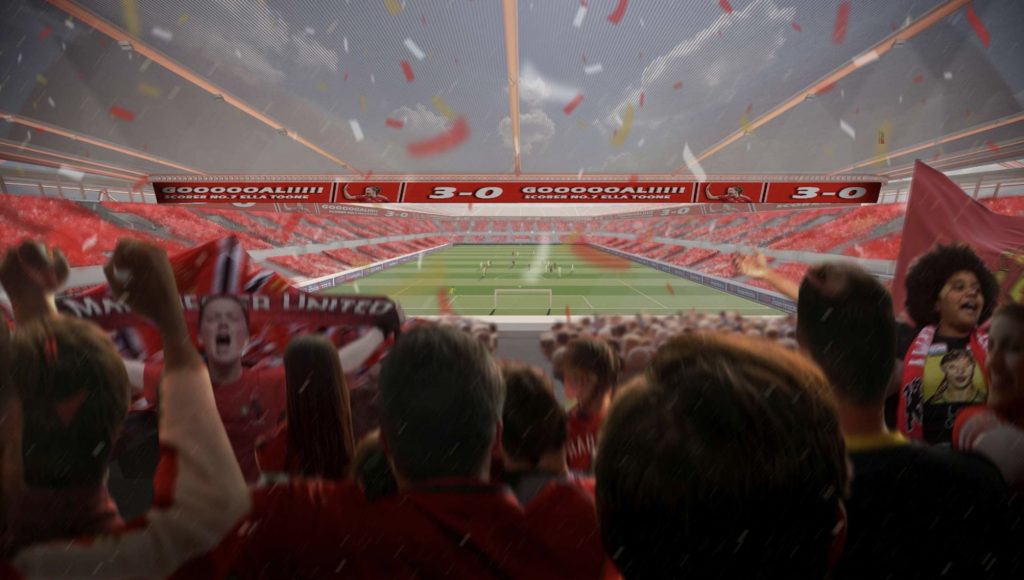Levelling the Playing Field: Reimagining Old Trafford for the Manchester United Women’s Team
A Bold Vision by Aran Kamil-Thomas to Challenge the Norms of Stadium Design
From the first sketches in studio to the final presentation pin-ups, Aran Kamil-Thomas—Part II Architectural Assistant and recent graduate from the Manchester School of Architecture—has never shied away from tackling the big issues in architecture. His culminating thesis project, “Levelling the Playing Field,” is a masterclass in both critical thought and creative problem-solving, offering a transformative vision for Old Trafford Stadium that is as provocative as it is practical.
A Thesis Rooted in Feminist Design Principles
For most, Old Trafford is synonymous with footballing grandeur, a symbol of Manchester’s sporting might and, historically, a bastion of male-centric culture. Aran’s thesis, however, disrupts this status quo. With a keen eye for inclusivity and sustainability—and a deep-rooted interest in sporting infrastructure—he has authored a proposal that reimagines the historic ground as a home for the Manchester United Women’s Team, underpinned by feminist design strategies.
Unlike typical adaptive reuse proposals that might merely add new amenities, Aran’s scheme interrogates the very DNA of stadium architecture. What if these colossal venues could embody equity, care, and dignity for all users, irrespective of gender? The project’s feminist-led approach is not just skin-deep but embedded in every design decision, from circulation to amenities. Here, design is activism, and architecture is a tool for social revolution.
Spatial Interventions: Feminist Technologies in Practice
At the heart of Aran’s proposal is a suite of targeted spatial interventions, each conceived as a ‘feminist technology’—design features that dismantle exclusion and foster belonging. The retained structural bowl of Old Trafford acts as a familiar anchor, but the experience within is entirely reimagined.
Accessible concourses wind through the stadium, designed not only for compliance but for genuine comfort and equity. Prayer rooms and sensory suites—spaces so often absent in mainstream stadium layouts—are woven into the fabric of the building, prioritizing the needs of neurodiverse visitors and those of diverse religious backgrounds. Family facilities take centre stage, distinctly absent from the traditional football experience, yet integral to Aran’s vision of care and support for every visitor.
Notably, these interventions are not afterthoughts, nor tokenistic gestures. Through rigorous user research and drawing from feminist theory, Aran has elevated these facilities into architectural protagonists. Each space—a sensory suite, a family facility, a gender-neutral bathroom—becomes a political statement, a challenge to the long-standing bias that stadiums are for “the boys.”
Storytelling as an Architectural Tool
One of the defining features of Levelling the Playing Field is Aran’s use of actor-led narratives to articulate and test his design. Rather than designing for an abstract “user,” Aran developed characters—Maya, an 11-year-old footballer; Tariq, a sensory-sensitive supporter; Roya, a young mother balancing childcare and fandom—each experiencing the stadium in different ways. This narrative-driven approach is both analytical and empathetic, resulting in spatial solutions that respond to real lived experiences rather than imagined norms.
These stories inform the spatial choreography of the scheme, ensuring that architecture serves its most important purpose: enabling richer, fairer, and more inclusive social interactions.
Sustainability and Adaptive Reuse: Beyond the Feminist Lens
While the feminist-led interventions are the project’s headline, Aran’s proposal doesn’t neglect the foundational architectural values of sustainability and technical rigour. Working with the original bones of Old Trafford, the design minimises waste and carbon impact through reuse. High-performance materials, innovative passive systems, and climate-responsive detailing knit together a proposal that is as ecologically sensitive as it is socially progressive.
Construction detailing and phasing strategies demonstrate how the vision could be implemented in practice, ensuring the scheme is not just a conceptual exercise but a viable roadmap for future stadium retrofits.
Recognition and Resonance
Levelling the Playing Field has already begun to create a stir within academic and professional circles, earning critical acclaim for its fearless confrontation with pressing issues in sports infrastructure. Aran’s blend of user-centred research, rigorous technical analysis, and unapologetic advocacy sets a new bar for how graduation projects can shape public discourse.
His thesis serves as an invitation—and a challenge—to fellow architects: can we, and should we, do more to make our public spaces places of equity? Can stadiums be more than temples to masculine achievement, and instead, serve as true civic commons?
Connect with Aran Kamil-Thomas
Aran Kamil-Thomas exemplifies the new generation of architects—passionate, principled, and unafraid to question received wisdom. If you are interested in inclusive design, sports infrastructure, or wish to support the future of equitable architecture, Aran welcomes further dialogue and collaboration. Connect with him via LinkedIn or reach out directly at arankt2000@gmail.com.
Levelling the Playing Field is not just a thesis; it is a call to action. For stadium design, for architecture, and for society at large—the game is changing.







Add a comment